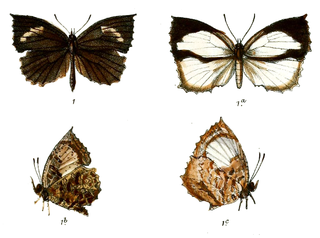
The small angle shades is a moth of the family Noctuidae. It is distributed throughout the Palearctic. The species was first described by Carl Linnaeus in his 1758 10th edition of Systema Naturae.

Apamea crenata, known as the clouded-bordered brindle, is a moth in the family Noctuidae. It is distributed throughout the Palearctic realm. In the North it crosses the Arctic Circle, in the Mediterranean it is found only in cool locations and mountains avoiding very hot areas. In the Alps, it rises to an altitude of about 2000 metres.

Meandrusa sciron, the brown gorgon, is a species of swallowtail butterfly found in parts of South Asia and Southeast Asia. It belongs to the hooked swallowtails genus, Meandrusa, of the family Papilionidae. The brown gorgon is found in India from Sikkim to Assam and north Burma and is not considered to be threatened. Though not uncommon, it is protected under Indian law under the name gyas.

Miletus symethus, the great brownie, is a small butterfly found in India that belongs to the lycaenids or blues family. The species was first described by Pieter Cramer in 1777.

Allotinus drumila, the crenulate darkie, is a small butterfly found in India, Burma, Thailand, Laos, Vietnam, and Yunnan (China) that belongs to the lycaenids or blues family.

Hypolimnas misippus, the Danaid eggfly, mimic, or diadem, is a widespread species of nymphalid butterfly. It is well known for polymorphism and mimicry. Males are blackish with distinctive white spots that are fringed in blue. Females are in multiple forms that include male-like forms while others closely resemble the toxic butterflies Danaus chrysippus and Danaus plexippus.

Curetis bulis, the bright sunbeam, is a species of butterfly belonging to the lycaenid family. It is found in Asia.

Hippotion celerio, the vine hawk-moth or silver-striped hawk-moth, is a moth of the family Sphingidae. It was described by Carl Linnaeus in his 1758 10th edition of Systema Naturae.

Allophyes oxyacanthae, the green-brindled crescent, is a moth of the family Noctuidae. The species was first described by Carl Linnaeus in his landmark 1758 10th edition of Systema Naturae. It is found in Europe.

Mesapamea secalis, the common rustic, is a moth of the family Noctuidae. The species was first described by Carl Linnaeus in his 1758 10th edition of Systema Naturae. It is found in Europe, north-west Africa, Turkey and northern Iran.

Grammodes stolida, the geometrician, is a moth of the family Erebidae. The species was first described by Johan Christian Fabricius in 1775. It is found in Africa, southern Europe, most of Asia and Australia. It migrates to central and northern Europe as far north as England, Denmark and Finland.

Asota ficus is a moth in the family Erebidae first described by Johan Christian Fabricius in 1775. It is found in Afghanistan, Bangladesh, China, Taiwan, India, Indonesia (Sumatra), Laos, Myanmar, Nepal, Pakistan, Sri Lanka, Thailand and northern Vietnam.

Mniotype adusta, the dark brocade, is a moth of the family Noctuidae. It was described by Eugenius Johann Christoph Esper in 1790. It is found throughout much of the Palearctic from Europe to Japan, China and Mongolia. It is also found in North America. The habitat consists of heathland, chalky downland, fenland, moorland and upland areas.
Aristotelia pyrodercia is a moth of the family Gelechiidae. It was described by Walsingham in 1910. It is found in Mexico (Guerrero).

Teliphasa similalbifusa is a species of moth of the family Pyralidae. It is found in China (Guangxi).
Megalopyge lapena is a moth of the family Megalopygidae. It was described by Schaus in 1896. It is found in Mexico and southern Arizona.
Megalopyge brunneipennis is a moth of the family Megalopygidae. It was described by Schaus in 1905. It is found in Brazil.
Megalopyge chrysocoma is a moth of the Megalopygidae family. It was described by Gottlieb August Wilhelm Herrich-Schäffer in 1856. It is found in Venezuela.
Megalopyge tharops is a moth of the family Megalopygidae. It was described by Caspar Stoll in 1782. It is found in French Guiana and Brazil.
Mesoscia lorna is a moth of the Megalopygidae family. It was described by Schaus in 1905. It is found in French Guiana.













